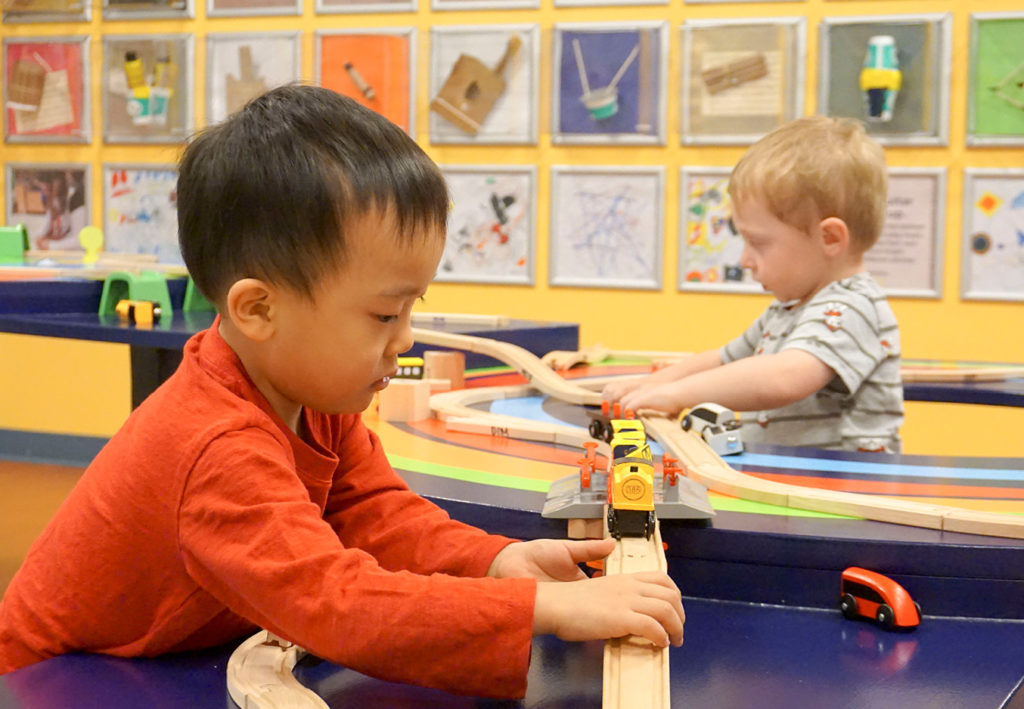Wild Wonders | Saturday, April 27

Wild Wonders | Saturday, April 27

By Alix Tonsgard, MS, Early Learning Specialist, DuPage Children’s Museum

Trains are back at DCM! Open-ended train play presents us with a window into the learning and development that take place during play. Children are learning about sharing, working together, negotiating, and conflict resolution — valuable lessons that help us negotiate the world we live in, as well as problem-solving, creativity, imagination, spatial reasoning, fine motor skills, dexterity, and communication skills.
You might think that play is play is play, but if you look at it through the lens of an early childhood nerd, there are actually many different types of play, all of which support different aspects of cognitive, social, physical, and academic development. Upon closer examination in our train exhibit, you will most likely bear witness to all stages and types of play.
Here are a few of the types of play you might expect to see:
The observers – While it may not appear that they are playing at all, this is actually a stage of play that is very important to some. Support this child by narrating what you see happening in the room and asking them what they see.

The solo players – Those who play alone tend to be more independent and self-sufficient. This type of play is also very age appropriate for the younger ones who are still developing communication skills.
The parallel players – These little ones like to play near other children, and while it may seem that they are playing alone, they are often mimicking other children and taking in all that is going on around them. Similar to this stage is one of my favorites to observe here at DCM. In the child development world it is referred to as associative play. This is when children are doing a combination of playing near each other but with each other at the same time. In this type of play, children are working on developing skills in problem-solving, language and communication, cooperation, and critical thinking.
The collaborators and the directors – As children develop into more social beings, some will want to play with other children and some will want to direct other children. This is where those social-emotional skills are really being put to work.
You play an important part in your child’s learning and development. We realize that playing with trains might not come as naturally to all adults, so here are some ways you can support your child:
Observe – Take some time to closely watch your child. You might be amazed by what they are capable of, what they know, what they want to know more about, and where you can support their learning.
Ask questions – Extend your child’s learning by asking open-ended questions to get them thinking. What would happen if…? What could you do differently? Where is your train going?
Set challenges – For the child that has reached a certain level of mastery, the next step is to challenge them to construct a bridge or build a track that uses 20 pieces. If they are not quite there, support them in completing the challenge together.
Stay tuned. Next blog I will talk about supporting your child in developing social-emotional skills as they navigate situations such as open-ended train play.
As always, I would love to hear what you think and answer any of your questions. Post on our social media outlets with the hashtag #PlayIQwithDCM so I can respond!
__________________________________________
About Alix
Alix Tonsgard is the Early Learning Specialist at DuPage Children’s Museum. She holds an MS in Child Development from the Erikson Institute. Acting as the Museum’s advocate for early childhood development and learning, she ensures that the latest research in Early Childhood Education is represented in all Museum exhibits, professional development initiatives, and public programs.

